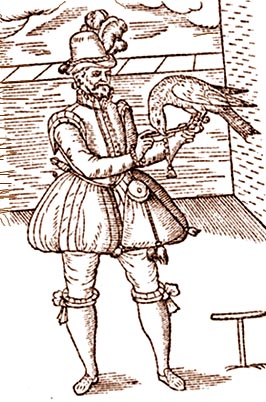

Falconry and Hawking as Sport

"Hawking, the hunting of other birds and game by the use of trained hawks, was established in Saxon England..." (Arlott, 25). There are between 38-45 species of true falcons in the world.
These birds were beautiful and cunning hunters who were trained through means of rewards to bond them to their master. Hawk training was considered a skilled art. Many preferred to get young hawks from their nests, while other birds were captured as adults. Hawks were a valuable commodity to their owners. A good hawk could do a variety of tasks such as the delivery of messages to their castles, in time of danger; hunt and kill other birds such as pheasant, duck, and geese; and small animals and ground game such as rabbits.

In the Book of St. Albans (1486), there is a listing of the various classes of falcons. The Book of St. Albans can be considered a compilation of gentlemanly activity as it contained three separate works within it's binding. The three works were those of Hunting, Hawking, and Heraldry. The heraldry section contains two categories - Coats of Arms and Blazons. Here is an excerpt from the Hawking category:
An Eagle for an Emperor.
A Gyrfalcon for a King.
A Peregrine for a Prince.
A Saker for a Knight.
A Merlin for a Lady.
A Goshawk for a Yeoman.
A Sparrow Hawk for a Priest.
A Musket for a Holy Water Clerk.
A Kestrel for a Knave.
A male falcon is called a tiercel. The legs of the falcon are attached with bells and jesses, which are short silk or leather straps that help the owner to keep track of their bird while out hunting. The color of the jesses tell us the prowress of each bird. In the Far East, the Goshawk wore purple jesses only after hunting and killing a Manchurian Crane, which is larger than the Goshawk.
THE FALCON IN LEGENDS:

Links:
SOURCES:
Arlott, John and Arthur Daley. Pageantry of Sport. New York: Hawthorne Books, Inc., 1968.
